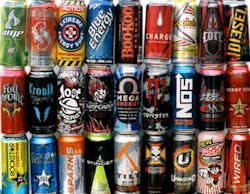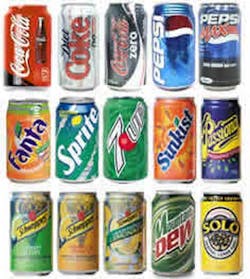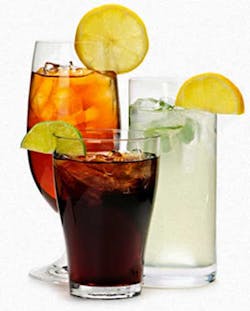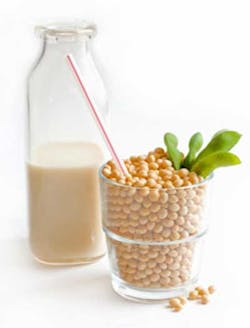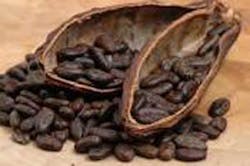Potentially toxic beverages
Ingestion of energy drinks has increased in recent years, and reservations in the scientific community and the public about the health effects of these products continue to be raised. Energy drinks are non-alcoholic beverages that contain caffeine, vitamins, and other ingredients, for example taurine, ginseng, and guarana. They are often marketed as agents to increase energy and enhance physical and mental performance. A literature review was conducted by individuals from the World Health Organization (WHO) Regional Office for Europe, on the health risks, consequences, and policies related to energy drink consumption.(1)
Energy drinks have been in Europe since 1987, and in the U.S. sales increased by about 10% per year between 2008 and 2012. About 500 new brands were introduced in 2006. The European Food Safety Authority estimates that 30% of adults, 68% of adolescents, and 18% of children below 10 years consume energy drinks.(1) Some of the risks of energy drinks are attributable to their high levels of caffeine, an excess of which can initiate heart palpitations, hypertension, nausea and vomiting, convulsions, psychosis, and in exceptional cases, death. As concerns about energy drinks seem valid, there is the potential for a substantial public health problem in the future. The researchers suggest further research and development of policy is essential to minimize the risk of harm from heavy and long-term energy drink consumption.
Energy drinks are not the only beverages making headlines. New research discloses new findings about other sugary drinks, such as the effects soft drinks may have on cellular makeup to teenagers’ decision-making habits in choosing which beverage to drink. According to one study, drinking sodas could cause extra cellular aging, resembling that of smoking cigarettes. The study investigated leukocyte telomere length, wherein shorter telomeres were associated with the risk of chronic diseases such as cardiovascular disease and diabetes. While telomeres shorten naturally with age, the study found that consuming a 20-ounce serving of a sugar-sweetened soda daily could result in shorter telomeres comparable to 4.6 years of cellular aging, a similar effect of smoking. More than 20% of the study’s participants drank this amount of soda daily. The conclusion of the study was that regular ingestion of sugar-sweetened sodas could affect metabolic disease development through accelerated cell aging.(2)
A different study discovered that the beverage decisions of African American teens’ were influenced by the product’s calorie information. The researchers positioned the signs in Baltimore corner stores in principally low-income and African American neighborhoods.(3) Facts on the signs included the number of teaspoons of sugar included in each beverage, and the amount of exercise it would take to burn off the beverage’s calories.
A 2012 study showed that soy milk is more likely than cow’s milk to cause acid tooth erosion. However, drinking soy milk infrequently is unlikely to cause problems with teeth. The study established that Streptococcus mutans applied to soy milk produced a five to six times more acidic environment, while cows’ milk did not cause the same change. The increased acidity of the soy milk is worrisome, particularly for babies, and especially if they sip milk from bottles throughout the day. The frequency could cause acid erosion. The article advises individuals to rinse their mouth with water, chew sugar free gum, and wait at least one hour before brushing after consuming acidic foods so as to help avoid erosion.
The bottom line – to prevent tooth decay and maintain good health and oral health, your diet is a prime factor. Alterations in the pH of the mouth begin immediately upon ingestion of certain beverages and foods. Bacteria in the oral cavity convert sugars and carbohydrates to acids, which attack the enamel on teeth, initiating the decay process. The more often someone snacks or drinks beverages, the more frequently they are exposing their teeth to the cycle of decay. The best beverage choices include water, especially fluoridated water, milk, and unsweetened tea.
There is some good news! A natural compound, resveratrol, found in some fruits, nuts, and red wine, may enhance exercise training and performance.(5) However, if you are imbibing resveratrol in the form of red wine, moderation is necessary.
Bottom line, choose your beverages wisely!
Maria Perno Goldie, RDH, MS, is the editorial director of RDH eVillage FOCUS.
References
1. Breda J, Whiting SH, Encarnação R, et al. Energy drink consumption in Europe: a review of the risks, adverse health effects, and policy options to respond. Frontiers in Public Health, published online 14 October 2014.
2. Leung CW, Laraia BA, Needham BL, et al. Soda and Cell Aging: Associations between Sugar-Sweetened Beverage Consumption and Leukocyte Telomere Length in Healthy Adults from the National Health and Nutrition Examination Surveys. American Journal of Public Health. (2014). Ahead of Print. http://ajph.aphapublications.org/doi/abs/10.2105/AJPH.2014.302151.
3. Bleich SN, Barry CL, Gary-Webb TL, Herring BJ. Reducing Sugar-Sweetened Beverage Consumption by Providing Caloric Information: How Black Adolescents Alter Their Purchases and Whether the Effects Persist. American Journal of Public Health. e-View Ahead of Print. http://ajph.aphapublications.org/doi/abs/10.2105/AJPH.2014.302150.
4. Dashper, SG, Saion BN, Stacey MA, et al. Acidogenic potential of soy and bovine milk beverages. Journal of Dentistry, Volume 40, Issue 9, 736 – 741.
5. Dolinsky VW, Jones KE, Sidhu RS, et al. Improvements in skeletal muscle strength and cardiac function induced by resveratrol during exercise training contribute to enhanced exercise performance in rats. The Journal of Physiology, 2012; 590 (11): 2783 DOI: 10.1113/jphysiol.2012.230490.
6. Brickman AM, Khan UA, Provenzano FA, et al. Enhancing dentate gyrus function with dietary flavanols improves cognition in older adults. Nature Neuroscience, 2014; DOI: 10.1038/nn.3850
